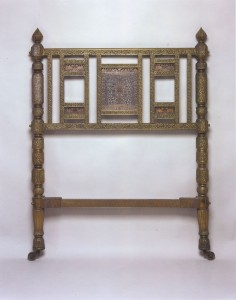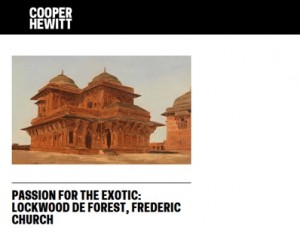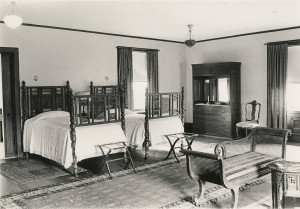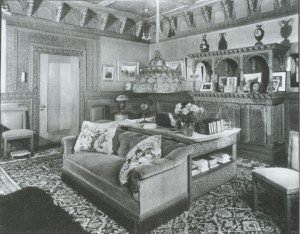Look out, New York City! A piece from our very own Bryn Mawr College’s Special Collections has already been carefully packaged and placed on a truck bound for the Cooper Hewitt Museum.

Bed. ca. 1885-1887. Designed by Lockwood De Forest. Manufactured by Ahmedabad Wood Carving Company. Chased brass over teak core, perforated copper. Gift of Mary Patterson McPherson, President of Bryn Mawr College, 1978-1997. Bryn Mawr College Collections. Photographed by Karen Mauch. (Deanery.454)
Our bronze nineteenth-century Indian headboard will be featured in one of the new exhibitions at the December 12, 2014 grand reopening of the Cooper Hewitt Museum, Passion for the Exotic: Lockwood de Forest, Frederic Church.

Opening Exhibitions at the Cooper Hewitt Museum in December 2014. From http://www.cooperhewitt.org/events/opening-exhibitions/. Accessed 23 October 2014.
The headboard is part of a set of two that were designed by American artist, Lockwood de Forest. De Forest is probably best known for his introduction of East Indian art to the American and European aesthetic in his role of a designer and importer of exotic goods. The headboard is one example of the many pieces created by the Ahmedabad Wood Carving Company in India and exported to New York for de Forest’s business. The headboard is made of chased brass and perforated copper panels decorated with East Indian floral and animal motifs over a teak wood frame.
The headboard made its way to Bryn Mawr College by way of Mary Elizabeth Garrett, who purchased the headboard from de Forest for her Baltimore home. In 1904 Garrett left Baltimore to live with her partner, M. Carey Thomas, at Bryn Mawr College. Garrett brought a large quantity of her furniture with her, including the headboard. The headboard is just one of many examples of de Forest at Bryn Mawr College, as he worked closely with Garrett and Thomas from 1894-1909 decorating and furnishing a large portion of their campus home in the College Deanery. While the College Deanery no longer stands, de Forest’s work remains part of the college’s collections and can be viewed online on TriArte, the art and artifacts database of Bryn Mawr’s special collections.

Beds in Mary E. Garrett’s Bedroom, Deanery, Bryn Mawr College. February 9, 1968. Photographed by Karl A. Dimler. (PAB_Deanery_072)
De Forest’s East Indian aesthetic designs, as well as the work of his former teacher Frederic Church, are the subject of the exhibition at the Cooper-Hewitt museum. The exhibition provides an excellent opportunity to view our headboard alongside other pieces designed by de Forest. In addition, the Cooper Hewitt Museum is located in the former residence of Andrew Carnegie, who commissioned de Forest to decorate his library in his signature East Indian style, which remains part of the museum’s collection today.

Family Library in the Andrew Carnegie House, New York, 1898-1901. Designed by Lockwood De Forest. Image from the Cooper Hewitt, National Design Museum, Smithsonian Institution, New York and the Museum of the City of New York, New York. Published in Roberta A. Mayer, Lockwood de Forest: Furnishing the Gilded Age with a Passion for India (Newark: University of Delaware Press, 2008) p. 168, fig. 148.
This exhibition will provide an exciting opportunity to see a piece of Bryn Mawr College history embedded in a broader narrative of international design.
The Cooper Hewitt Museum has announced December 12, 2014 as the date of their grand re-opening.
